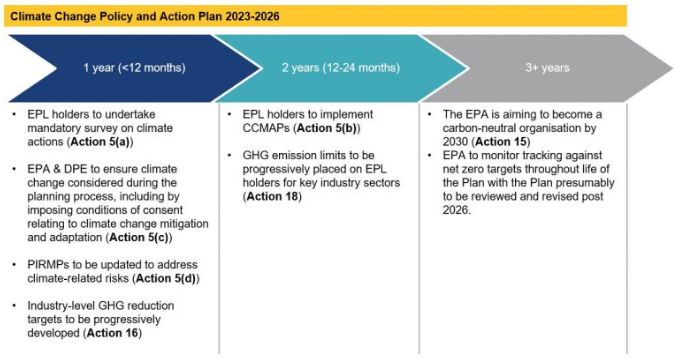The NSW Environment Protection Authority (EPA) has published its Climate Change Policy and Action Plan 2023-2026 (Plan).
Over the next 12-24 months, under the Plan, the EPA will introduce a number of new requirements for industry participants to take action in response to climate change. Climate Change Mitigation and Adaptation Plans, industry-wide emission-reduction targets and emission limits on environment protection licences (EPL) are some of the proposed actions.
Snapshot
- Following the decision in Bushfire Survivors for Climate Action Incorporated v Environment Protection Authority [2021] NSWLEC 92 (2021) 250 LGERA 1, the EPA prepared the Plan, which puts a significant focus on climate change action across the industries and activities that the EPA regulates.
- The Plan identifies 11 existing and 18 new actions to be taken by the EPA between 2023 and 2026 to address climate change, under three pillars: 'inform and plan', 'mitigate' and 'adapt'.
- Key actions under the Plan include:
- requiring EPL holders to prepare Climate Change Mitigation and Adaptation Plans (CCMAPs) and update pollution incident response management plans (PIRMPs) to address climate change;
- progressively setting industry greenhouse gas emission reduction targets, as well as gradually imposing emission limits on EPL holders; and
- working with other agencies to require more robust assessment of climate change issues as part of the planning approval process, particularly for EPA regulated activities and government infrastructure projects.
Background
The Plan was prepared following the decision in Bushfire Survivors for Climate Action Incorporated v Environment Protection Authority [2021] NSWLEC 92 (2021) 250 LGERA 1, in which the EPA was ordered to develop environmental quality objectives, guidelines and policies to ensure environment protection from climate change (see our earlier blog post on the decision here).
The Plan identifies 11 existing and 18 new actions to be taken by the EPA under three pillars: 'inform and plan', 'mitigate' and 'adapt'.
In some instances, the actions captured by the EPA in the Plan will only formally recognise what industry is already achieving in terms of climate action. However, we anticipate that there will remain an administrative, financial and operational burden on EPA-regulated industries and activities to achieve compliance in the short-term as a result of some of the actions set out in the Plan.
The EPA identified the primary feedback from industry sectors during consultation on the draft Plan was concern about duplication of climate regulation across different levels of government. The EPA says it is alive to this issue and the Plan is intended to complement rather than duplicate or conflict with other approaches: Consultation Summary Report.
The Plan identifies both actions that the EPA will take as well as significant amounts of consultation and collaboration it will undertake with other agencies including the Department of Planning and Environment (DPE), Office of Energy and Environment (NSW Treasury) (OECC) and Infrastructure NSW.
Actions likely to have the most impact on industry
Some of the new actions set out in the Plan that, in our view, will have the most impact on industry are summarised out below.
1. EPL holders will need to undertake a mandatory survey about climate change actions (Action 5(a))
In the first year of the Plan (from 2023), EPL holders and public authorities will be required to undertake a mandatory survey.
The survey will ask participants:
- how they are contributing to the NSW Government's climate change objectives;
- what climate change actions they are already taking; and
- how the EPA can support them to build capacity to take action against climate change.
The survey results will be used to inform where the EPA should focus its regulatory efforts to address climate change.
2. EPL holders will be required to implement climate change mitigation and adaptation plans (Action 5(b))
Starting in the second year of the Plan (from 2024), the EPA will progressively require EPL holders to prepare and implement CCMAPs. CCMAPS will need to show how organisations have considered ways to minimise their greenhouse gas emissions and exposure to climate risk.
Similar to existing requirements for PIRMPs, CCMAPs (or sections of them) and progress updates will be required to be published on corporate websites.
The EPA is considering using EPL conditions to expressly require actions identified in CCMAPs to be implemented.
EPA guidelines (including templates) will be published to assist with preparing CCMAPS.
3. Pollution Incident Response Management Plans will need to be progressively updated to consider climate-related risks (Action 5(d))
EPL holders will progressively be required to update their PIRMPs to expressly consider how climate change might increase the risk of pollution incident.
The EPA will update its PIRMP guidelines to assist licencees in assessing their exposure to climate risks.
4. The EPA will develop greenhouse gas emission reduction targets for key industry sectors (Action 16)
The EPA, OECC and DPE will develop emission reduction targets for certain industries.
While the EPA has not identified which industries will be subject to the targets, the Plan indicates that the EPA will focus its efforts where it can "achieve the greatest gains".
As the targets will apply to whole industry sectors, they will not be enforceable.
5. The EPA will progressively place greenhouse gas emission limits and other requirements on EPLs for key industry sectors (Action 18)
The EPA will progressively impose greenhouse gas emission limits and other requirements on EPLs. Emission limits will be informed by the sector emission reduction targets developed under Action 16. However, unlike the targets, the limits imposed as conditions of EPLs will be enforceable.
In addition to emissions limits, the EPA will also look to impose licence conditions such as:
- monitoring and/or emission estimation conditions;
- other performance requirements;
- reporting conditions; and
- pollution reduction studies and programs.
As part of Action 18, the EPA is also aiming to place conditions on all NSW coal mine licences during 2023 to require all new large non-road diesel machinery to meet US EPA Tier 4 emission standards (or better).
6. The EPA will work with DPE to ensure climate change is being adequately addressed by proponents (Action 5(c))
The EPA and DPE will work to ensure that climate change mitigation and adaption is addressed through the planning process. The key actions described in the Plan which will be undertaken as part of the planning process are high level, but will include:
- developing climate change guidance and place-based policies;
- requiring proponents to adequately consider climate change in their applications; and
- developing appropriate climate change conditions for approvals.
As part of Action 5(c), the EPA, DPE, Infrastructure NSW and the Officer of Energy and Climate Change (OECC) will adopt consistent carbon reporting requirements for public infrastructure projects.
Timing overview
A number of the actions summarised above will take place (or start to be implemented) in the first two years of the Plan, requiring almost immediate action by industry. An overview of the key timeframes is below:

Key takeaways
- In our view, the Plan is a fairly comprehensive response to the court's criticism of the EPA in the Bushfire Survivor's decision. It proposes a number of actions that are achievable without legislative reform. It will be interesting to monitor the EPA's success with the actions that do not have a compliance mechanism built in and see what, if any, changes the EPA proposes in 3 years' time.
- For now, there will be a significant wave of regulatory reform for EPL holders and proponents of development in industries regulated by the EPA between 2023 and 2026.
- Individual licence-holders as well as broader industry sectors will need to set aside resources to address the additional burden of the proposed regulatory reform and should consider planning for action in advance of any regulatory changes.
- To the extent that some industries are progressed further down the climate change mitigation path than others, the Plan will create winners and losers. For example, the Plan recognises the EPA's commitment to supporting the whole-of government approach to streamlining project approvals in renewable energy zones (Action 11) - a win for the clean energy sector. However, the additional focus on climate change impacts through the planning process (Action 5(c)) is likely to continue the trend of making it more difficult to achieve consent for emissions intensive industries such as coal mining and coal-fired power generation.
If you would like to understand what the Plan means for your operations, please do not hesitate to get in touch.
The Climate Change Policy and Plan can be found here.
The content of this article is intended to provide a general guide to the subject matter. Specialist advice should be sought about your specific circumstances.



